
ARC-Grain Crops,
Potchefstroom
Oilseed crops are the second-largest source of food after cereals, with a large expansion worldwide due to high demand for vegetable edible oil. Sunflower (Helianthus annuus L.) is one of the four most important oilseed plants in the world, along with palm, soybean and rapeseed.
In South Africa sunflower is the most significant oilseed crop – it is the largest source of vegetable oil followed by soybeans and canola. Annually, almost the entire local sunflower crop is intended for the processing industry to be converted to sunflower oil. In the 2018/2019 marketing year, South Africa produced 315 406 tons of sunflower oil, which is the most widely consumed vegetable oil in the country. In the same year 379 395 tons of oilcake were produced.
Oil-type sunflower seeds contain from 38% to 50% oil and about 20% protein. Sunflower oil consists mainly of a combination of mono-unsaturated and polyunsaturated fats with low saturated fat levels, making it a healthy and high performance non-transgenic fat and a desirable option for human consumption. Moreover, studies have shown that sunflower oil is healthier than most other food oils on the market; it is light in taste and appearance and supplies more vitamin E than any other vegetable oil.
The oil concentration of the sunflower seeds at maturity is known to vary among cultivars, therefore much effort by plant breeders are aimed at increasing the oil concentration in mature achenes of modern oilseed cultivars. The oil content and oil yield are complex quantitative traits, determined by genetic and environmental factors, along with interactions between them.
 According to the Bureau for Food and Agricultural Policy (BFAP), South Africa’s sunflower oil consumption increased by 63% since 2008. Over the next decade, an increase of 41% in sunflower oil consumption has been projected and although slower than the past decade, it remains significant. As domestic consumption is projected to remain higher than production, South Africa will remain a net importer of sunflower crude oil.
According to the Bureau for Food and Agricultural Policy (BFAP), South Africa’s sunflower oil consumption increased by 63% since 2008. Over the next decade, an increase of 41% in sunflower oil consumption has been projected and although slower than the past decade, it remains significant. As domestic consumption is projected to remain higher than production, South Africa will remain a net importer of sunflower crude oil.
Currently South Africa does not necessarily see higher premiums being realised for a higher oil yield, compared to countries like the United States, where a 2% premium is paid for each percentage point of oil content exceeding 40%. However, good-quality sunflower hybrids can be advantageous to increase sunflower production in South Africa.
The national sunflower cultivar trials conducted by the ARC-Grain Crops assist producers to choose the correct cultivar that is best suited to their respective environments. This in turn ensures higher profits at no extra cost.
To investigate the performance of commercially available sunflower hybrids from different seed companies, hybrids were evaluated for oil and protein content in the Free State and North West. 19 sunflower hybrids were evaluated at seven sites during the 2017/2018 growing season and 24 hybrids were evaluated at six sites during the 2018/2019 growing season. A randomised complete block design with three replicates was executed for each site. Seed yield was recorded for each site individually and seed samples were sent to the Southern African Grain Laboratory (SAGL) for oil and protein content analyses. Seed oil yield was calculated by multiplying oil content (%) with seed yield (t/ha).
Results obtained
Oil content (%)
Obtaining varieties with higher oil concentration appeared to be an alternative track for enhancing sunflower production and could become a plus value for South African producers. Significant differences were observed among tested hybrids during both growing seasons. In the 2017/2018 growing season across hybrids, the moisture-free oil content varied from 38,84% (P 65 LP 54) to 48,44% (SY 3970 CL) with an overall mean of 41,58%. The following hybrids produced higher or even oil contents than the average: SY 3970 CL, P 65 LL 02, P 65 LL 14, PHB 65 A 70, AGSUN 5270 and PAN 7100 as shown in Graph 1. In the 2018/2019 growing season and across hybrids, the moisture-free oil content varied from 40,65% (AGSUN 5101 CLP) to 51,53% (SY 3970 CL) with an overall mean of 43,43%. Ten sunflower hybrids produced more than the average oil content (SY 3970 Cl, LG 5710, SY Arizona, LG 5678 CLP, P 65 LL 02, SY 3975 CLOH, P 64 LL 23, P 65 LL 14, PAN 7100 and AGSUN 5270) as shown in Graph 2.
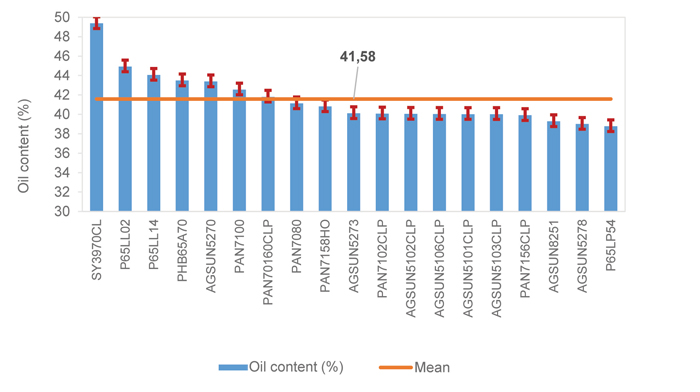
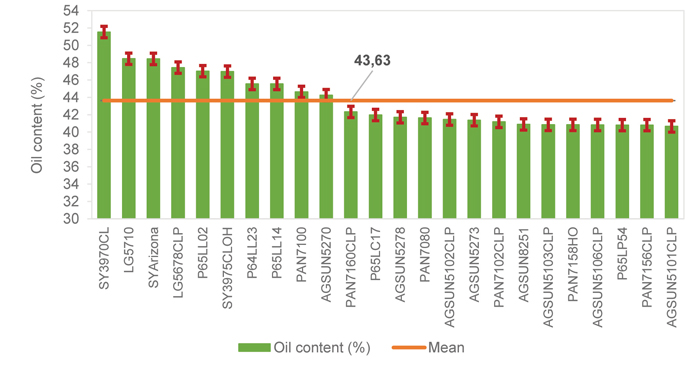
Protein content (%)
Sunflower seeds are mostly used for their oil, but as with other oilseeds, the meal left behind after oil extraction is a valuable byproduct because of its high protein content. Protein represents the main subproduct of the sunflower oil industry and its concentration in the grain can vary between 15% and 19%, depending on the oil content (oil and protein concentration are inversely related). Graph 3 shows the moisture-free protein content for the 19 cultivars evaluated at seven localities during the 2017/2018 growing season. Protein content varied from 16,73% to 19,80% with an overall mean of 18,63%. AGSUN 5101 CLP recorded the highest protein content at 19,80% followed by AGSUN 5103 CLP (19,51%). The following hybrids produced higher or even protein contents compared to the average: AGSUN 5101 CLP AGSUN 5103 CLP, AGSUN 8251, P 65 LP 54, AGSUN 5278, AGSUN 5102 CLP, AGSUN 5273, AGSUN 5106 CLP, SY 3970 CL and PAN 7102 CLP. In the 2018/2019 growing season, the moisture-free protein content varied from 16,44% to 19,15% with an overall mean of 16,44%. SY 3975 CLOH produced the highest protein content (19,15%) among cultivars and calculated across localities, followed by LG 5678 CLP (19,03%). The following hybrids produced higher or even protein contents compared to the average: SY 3970 CLOH, LG5678 CLP, AGSUN 5101 CLP, AGSUN 5270, AGSUN 5103 CLP, AGSUN 5106 CLP, AGSUN 5278 and AGSUN 8251 as shown in Graph 4.
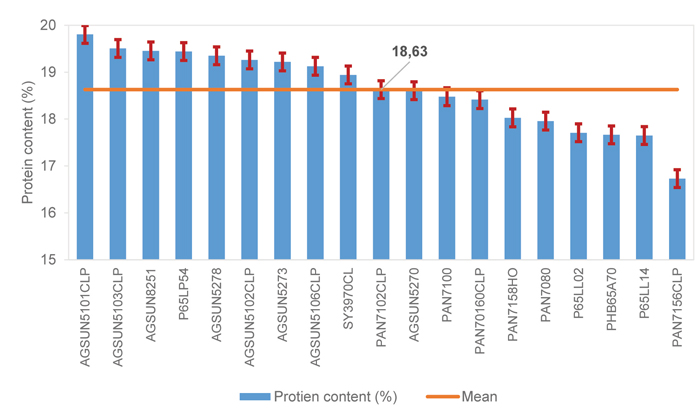
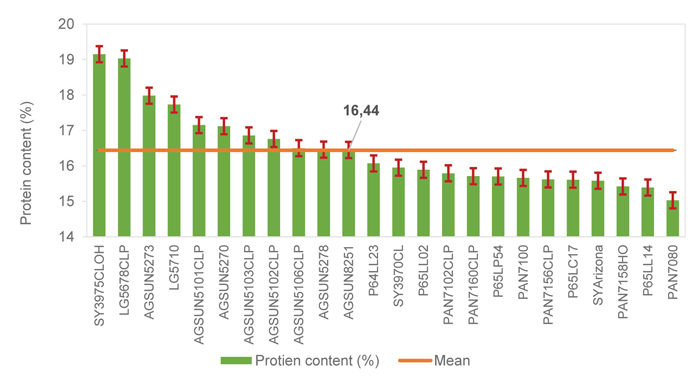
Oil yield (t/ha)
Oil yield per unit area is the product of grain yield and seed oil content (t/ha) and was calculated by multiplying oil percentage with seed yield. Significant differences were recorded among the sunflower hybrids during both growing seasons (Graph 5 and Graph 6). The oil yield for the 19 sunflower hybrids at the seven localities during 2017/2018 varied from 0,90 t/ha to 1,11 t/ha with an overall mean of 1,00 t/ha. During the 2018/2019 growing season, the oil yield varied from 0,98 t/ha to 1,26 t/ha with an overall mean of 1,10 t/ha. P 65 LL 02 produced the highest oil yield during both growing seasons followed by PAN 7160 CLP and SY Arizona for 2017/2018 and 2018/2019 respectively. Our results showed that 47% to 50% of the tested hybrids are above the oil yield average for both growing seasons (Graph 5 and Graph 6).
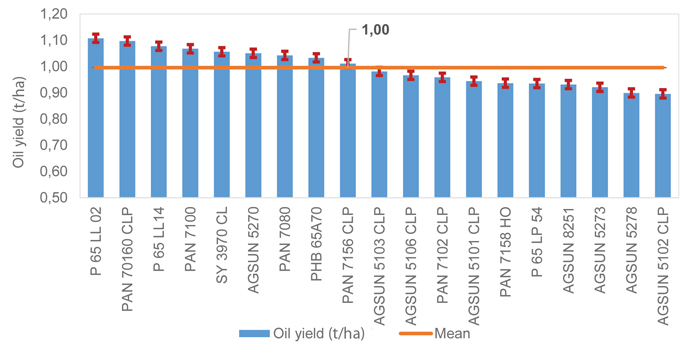
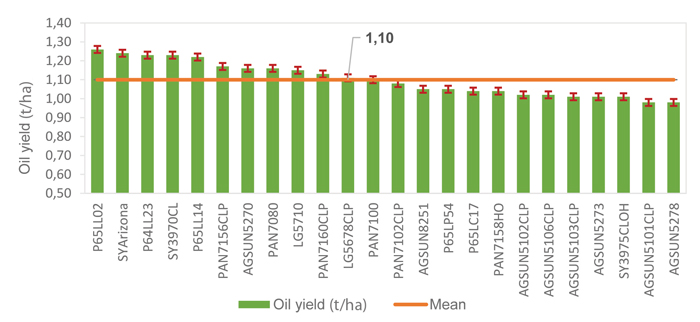
Conclusion
This study identified sunflower hybrids that can produce high oil contents in the North West and Free State production areas, that are well above the current norm (36% oil content with moisture percentage of less than 10%) as required for the industry at South African silos.
In the 2017/2018 growing season, 95% of the tested hybrids achieved more than the required protein content by the processing industry which is approximately 17% or higher. However, in the 2018/2019 growing season, only 20% of the tested hybrids achieved more than the required protein content for the processing industry.



















